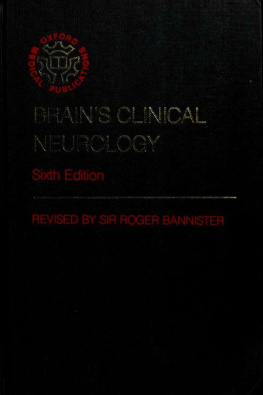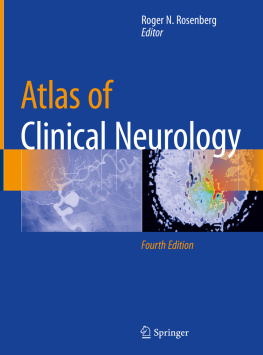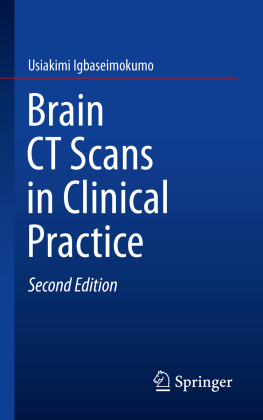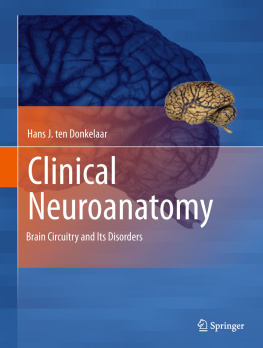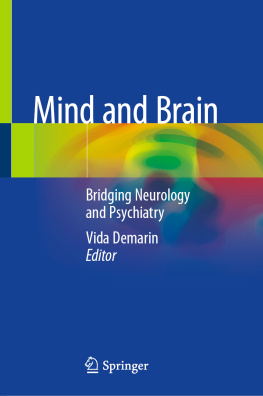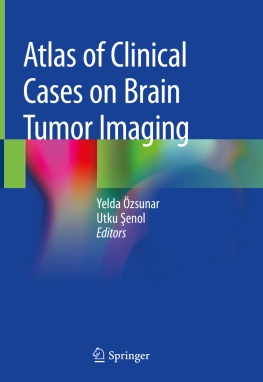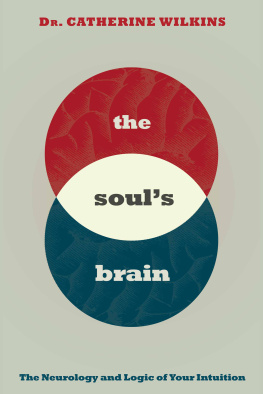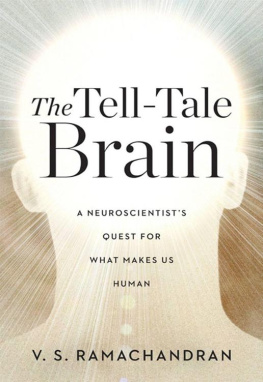Walter Russell Brain - Brain’s Clinical Neurology
Here you can read online Walter Russell Brain - Brain’s Clinical Neurology full text of the book (entire story) in english for free. Download pdf and epub, get meaning, cover and reviews about this ebook. year: 1985, genre: Detective and thriller. Description of the work, (preface) as well as reviews are available. Best literature library LitArk.com created for fans of good reading and offers a wide selection of genres:
Romance novel
Science fiction
Adventure
Detective
Science
History
Home and family
Prose
Art
Politics
Computer
Non-fiction
Religion
Business
Children
Humor
Choose a favorite category and find really read worthwhile books. Enjoy immersion in the world of imagination, feel the emotions of the characters or learn something new for yourself, make an fascinating discovery.
- Book:Brain’s Clinical Neurology
- Author:
- Genre:
- Year:1985
- Rating:5 / 5
- Favourites:Add to favourites
- Your mark:
- 100
- 1
- 2
- 3
- 4
- 5
Brain’s Clinical Neurology: summary, description and annotation
We offer to read an annotation, description, summary or preface (depends on what the author of the book "Brain’s Clinical Neurology" wrote himself). If you haven't found the necessary information about the book — write in the comments, we will try to find it.
Brain’s Clinical Neurology — read online for free the complete book (whole text) full work
Below is the text of the book, divided by pages. System saving the place of the last page read, allows you to conveniently read the book "Brain’s Clinical Neurology" online for free, without having to search again every time where you left off. Put a bookmark, and you can go to the page where you finished reading at any time.
Font size:
Interval:
Bookmark:

This book made available by the Internet Archive.

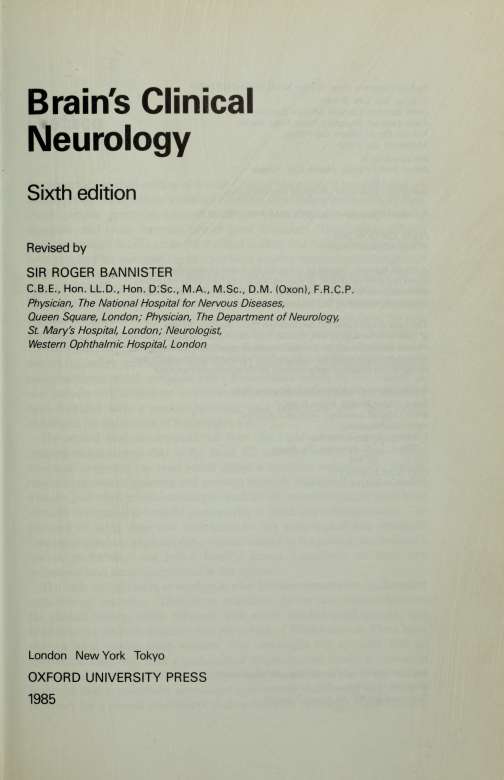
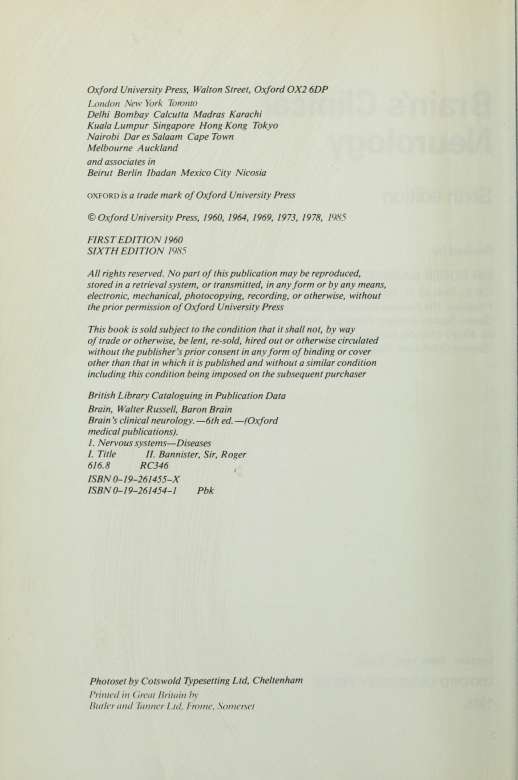
Preface
In preparing the sixth edition of Brain's Clinical Neurology, it has still been my aim to preserve Lord Brain's original intention of writing a textbook for physicians, general practitioners, and students which explains clearly how to diagnose and treat common neurological disorders. The present edition includes enough detail to take the medical student and young doctor up to the level required for membership or equivalent general medical specialist qualifications. It aims to be readable and moreover capable of being read within the span of a brief neurological course. In the past five years there have been two exciting developments in particular which have changed the practice of neurology more fundamentally than at any time in the past 20 years: first, the new generation of neurotransmitters and secondly, the new imaging techniques.
Who would have imagined 20 years ago that in addition to the classical transmitters (including substance P and GABA) more than 30 neuropeptides and neurohormones which modulate nerve transmission would be discovered? A new introductory section on neurotransmitters and endorphins has therefore been included with a section reviewing pain perception and some newer techniques for the control of intractable pain.
The second new development has been the rapid advance of diagnostic imaging techniques so that to the latest CT scanners with computer 'reconstruction' programs has been added digital subtraction angiography, nuclear magnetic resonance scanning and positron emission tomography. Some earlier invasive and often painful techniques such as air encephalography have been virtually dropped and cerebral angiography is much less often necessary. The prospect of using these new techniques to link pathological and metabolic changes at precisely localized sites, without hazard to the patient, has become a realistic probability, not just a fanciful dream. Comments on these new techniques have been incorporated in this edition.
The basic text still seeks to emphasize what I believe remains the fundamental attraction of neurology. There is an orderliness in the neat balance between the clinical history, often entwined with subtle psychological aspects, and knowledge of the basic anatomy and physiology of brain function. These basic sections have needed some revision. The neurologist has to make first an anatomical diagnosis, then a pathological diagnosis, and finally a functional assessment in terms of the patient's management. Recently I was rather surprised that a consultant neurologist commented that he did not think it necessary for a general practitioner to do a complete neurological examination
vi Preface
because it was so difficult. A careful history is very important but the simple neurological examination cannot be neglected and this book aims to remove any anxieties about the examination techniques. A guide to an abbreviated neurological examination to exclude gross neurological disease has been included in this edition.
My aim has also been to provide some insight into the exciting new scientific developments provided in neurology in the hope that these will stimulate the reader but not divert him too much from the core of basic neurological information.
Neurological treatment, becoming in many diseases a much more complex matter of drug manipulation of receptors, has required extensive revision. For example neurologists are being faced with more problems in the late stages of Parkinson's disease when 'on/off symptoms and dyskinesias result from different types of pre- and postsynaptic disturbances. In addition, we are only just beginning to see attempts, as yet unsuccessful, to apply the same principles of neurotransmitter modulation to other neuronal degenerations such as Huntington's chorea and Alzheimer's disease. As it is impossible to cover all the advances in neurology, some areas, for example paediatric neurology, which have become neurological specialties in their own right have been abbreviated and are therefore necessarily incomplete. Despite resisting the temptation to attempt to cover all topics the length of the text has had to be increased. In this edition particular attention has also been given to the revision of the sections on the common neurological disorders of dementia, cerebrovascular disease, and the assessment of coma and brain-death, particularly as the medicolegal and ethical aspects of brain-death have become increasingly a matter of public interest and debate. New material in this edition is also included in sections on c.s.f. globulins and serology, language function and handedness, sleep disorders,* virus diseases, myasthenia, hereditary degeneration, pituitary tumours and prolactinomas, mitochondrial myopathies, autonomic function, multiple sclerosis, and epilepsy.
London R.B.
August 1984
Acknowledgements
It is a pleasure to acknowledge the debt I owe to my colleagues for many helpful discussions and for material used for illustrations. In addition to the acknowledgements made in previous editions I would like to thank the following: Dr D. Carr, of Harvard Medical School, who kindly advised on the section on neuropeptides, endorphins, and pain and provided Figs. 0.7, 0.8, 0.9 (after Melzack and Wall), and 0.10 (after Fields). Professor J. Z. Young (Fig. 0.4); Dr D. Sutton and Churchill Livingstone for kindly providing most of the radiological illustrations, which appeared in Textbook of radiology and imaging 3 /q; Miss S. Ford (fundus photographs. Fig. 2.3, Plates 2,3, and 4), the Department of Audio-Visual Communication at St Marys Hospital, London, and the Photographic Department at the National Hospital, Queen Square, London; Dr J. A. Morgan Hughes (Plate 8); Dr D. N. Landon (Fig. 20.5); Professor R. F. Schmidt and Springer Verlag (Figs. 3.9, 3.10, 3.2, 4.1, 7.10, 17.2, and 17.2, which appeared in Human physiology (ed. Schmidt and Thews 1983); Dr J. A. R. Lenman and Pitman Publishing (Fig. 5.11, which appeared in Clinical electromyography 3/e (ed. Lenman and Ritchie));Professor C. D. Marsden and The Lancet (Fig. 16.2); Dr J. Gilroy and Macmillans (Figs. 2.4, 2.7, 2.8, and 2.20, which appeared in Medical neurology (by Gilroy and Meyer); Professor A. Richens and Churchill Livingstone (Table 7.1, adapted from A textbook of epilepsy (ed. Laidlaw and Richens 1982)); Dr A. M. Halliday and Butterworths (Fig. 5.8, which appeared in Clinical neurophysiology (ed. Stalberg and Young)); Professor J. W. Lance and Professor J. G. McLeod and Butterworths (Figs. 3.1, 5.10, and 5.11, which appeared in A physiological approach to clinical neurology); Dr G. Bydder, Department of Diagnostic Radiology, Royal Postgraduate Medical School, London (all the NMR scans); Dr A. R. Valentine (Fig. 5.9); Dr R. Wise, Physics Isotopes Section, MRC Cyclotron Unit, Royal Postgraduate Medical School, London (Fig. 14.9); Dr B. Pansky and Macmillans (Fig. 2.1, which appeared in Review of neurosciences (ed. Pansky and Allen 1980)); Dr T. Nikaido (Fig. 10.4, which appeared in Archives of Neurology 25); and Dr M. Rosser and the Update Group (Fig. 16.4, which appeared in Update).
Vll
Font size:
Interval:
Bookmark:
Similar books «Brain’s Clinical Neurology»
Look at similar books to Brain’s Clinical Neurology. We have selected literature similar in name and meaning in the hope of providing readers with more options to find new, interesting, not yet read works.
Discussion, reviews of the book Brain’s Clinical Neurology and just readers' own opinions. Leave your comments, write what you think about the work, its meaning or the main characters. Specify what exactly you liked and what you didn't like, and why you think so.

